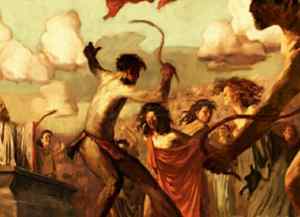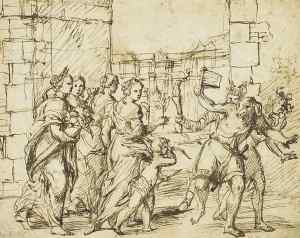Tis’ the season for buying over-priced roses, heart shaped boxes filled with low quality chocolates and of course, the once a year question of the holiday’s background. In an ongoing examination of our holidays, their history and the contemporary values that they may or not project, let’s begin 2014 with my little bloody valentine.
However St. Valentine’s Day has the added advantage of deriving from several equally fascinating historical points of interest. The Ancient celebration of the Roman God Lupercus, thus Lupercalia and the violent demise of at least two, though possibly 3 Valentines.
There are 3 Ancient Roman Catholic saints named Valentine, though they come from fairly varied backgrounds only two were executed by the Emperor Claudius II, who is the villain of the story, and to clear things up, most people speak about one specific St. Valentine, even if they are unclear which one it is, Valentine of Rome or Valentine of Terni. However since the story’s truth is very questionable at best, it really doesn’t matter too much in the first place. It is a good story though, I have even read it to my daughter the night before she was set to pass out valentines with Disney Princesses and little candied hearts. Though rather than tell you the cutesy pro-Church story, I will instead tell this:
Claudius and Valentine
In the year 268, Rome was in the midst of one of its greatest disasters, what would become known as the Crisis of the 3rd Century. Plagues were running rampant, emperors were weak and ineffective and the Empire had been cut into 3 warring pieces. Much of the East had been seized in a coup by the Queen Zenobia of Palmyra, while Spain, France and Britain broke off and declared a new Empire, called the Gallic Empire. What remained was in turmoil and invading forces stood poised to hack flesh from the dying Roman corpse.
A series of weak aristocratic Emperors had been ineffective. A man named Gallienus was in power, yet the situation was proving to be far too grave for him to manage. The once mighty Roman Army was looking weak. Franks, Alamani, Juthungi, Scythians and the mighty Sassanids in the East had invaded under his reign. Even an emperor, just 8 years prior, Gallienus’s father Valerian, had been captured in battle (a first in Roman history) and subsequently killed in captivity, possibly by having molten gold poured down his throat.
Now an army possibly as large as 325,000, one of the largest armies in ancient history broke through the Roman borders and invaded Greece, sacking many cities, including Athens. The tale proclaims that the Goths gathered the great books of the Greeks to be burned yet decided it was better to leave the Greeks to their books then to leave them to their swords. The Barbarians were through the gates and the Army had lost confidence in Gallienus. In typical Roman fashion, he was mysteriously betrayed and none of the people that profited from his death were to blame.
One such man was Claudius. Taking the throne as Claudius II, he had been one of the top generals of the Empire. He was an army man, a soldier who rose through the ranks to become Gallienus’ top deputy and head of the elite cavalry force. Now he was head of an ailing empire, plagued by civil war and military invasions. He was respected by his army, though, possibly due to his strength and his cruelty. It was once claimed that he punched a horses teeth out with one punch.
Now Claudius II had to meet the large army head on and there was no time to lose. However there was a shortage of men for battle. As his own soldiers longed to be with their wives and families, Claudius decided it was the age old Roman institution of marriage that was to be blamed. He immediately decreed that no one in the Empire was to be married.
As you might have guessed, this did not sit well with many Romans, though it most of all offended the rapidly growing sect of Christians, among them, an Umbrian priest named Valentine. He refused the imperial decree and married young couples anyway. He believed their only crime was being in love and uniting these couples in Christian commitment would save their souls. He went on in his defiance until he was finally caught.
On one account, he was placed under house arrest by a local judge. He convinced the judge to convert to Christianity and not only was allowed to flee, other Christian prisoners were also set free. After he went on decreeing his faith and marrying young couples, he was caught again and brought before the Emperor Claudius II.
Claudius was deeply interested in this gentle man that defied his rule, so he spared him execution though had him thrown in prison. While there he continued to marry couples in secret. One story declares that he proselytized his Christian faith to fellow inmates and prayed with a man named Asterius and his blind daughter, restoring her sight.
The Emperor got word and hauled Valentine before him. As he was taken, he passed a note to Asterius to give to his daughter that read “from your Valentine.”

The brutal execution of Valentine from the Middle Ages. Made in a time when brutal executions made good art.
However Claudius took pity again on Valentine and sincerely liked him. It wasn’t until the future saint tried to convert the Emperor that he was condemned. He was beaten with clubs. When that did not kill him, he was stoned. When that did not kill him he was beheaded outside of the Flaminian Gate in Rome.
Claudius, now in possession of his army went on to meet the dreaded Goths at the Battle of Naissus. In a fake retreat, the Goths rushed in as a cavalry led by the general Aurelian smashed into the Gothic lines. It was a heroic victory that earned the emperor the title of Claudius “Gothicus”, meaning “conqueror of the Goths”. Some 50,000 Gothic warriors were killed or captured. Others slunk into the mountains where one of the plagues had caught up to them. Much of the remaining army perished. The attack was so absolute the Goths don’t emerge in history for another 100 years!
Yet Claudius himself was infected and on his way back to the capital he fell ill and died. Claudius was made a god in the Roman religion. He had ruled the empire for less than a year and a half.
His successor and top general Aurelian went on to reunite the Empire, before being betrayed by his top soldiers, one of them was possibly Diocletian, who likely destroyed the records of Valentine in his failed anti-Christian purge. The Empire would live on for nearly 200 years longer and would soon become a Christian empire less than 50 years there after.
As for Valentine, he was declared a Saint and his forever commitment to love would be celebrated in mid February.
Now for the Facts
The truth is that it is highly possible that we know nothing truthful about that entire story. The 3rd century was likely a chaotic and confusing time to live through and the lack of stability probably led to less than stellar record keeping. Sadder still is we don’t really even know that much for sure. What we do know is that records for these events are spotty at best, dates are often different in the few accounts there are and much of the information comes from later sources.
Though that doesn’t mean that nothing is likely true. There are coins, battle monuments, paintings and a few books that survive. So along with other archaeological evidence, stories are woven together. In some cases like this, large holes remain and the potential for bias among the few surviving writers is almost a certainty. For instance, new monuments found in Persia suggest that Emperor Valerian was not treated poorly in Sassanid Persia and the writings of a Christian scholar, Lacantius, who tells the molten gold story may have been colored by his anti-Persian views due largely to the anti-Christian persecutions at the time of his writing.
When it comes to Valentine, nothing can be proven. No records survive from the Church from this period, probably due to the Christian persecutions of Diocletian (as mentioned above). So anything about Valentine comes from the legend and stories written hundreds of years later and more. The Nuremburg Chronicle was over 1200 years later. So nearly everything that pertains to Valentine is highly questionable, at best.
Also Valentine was supposedly killed in Rome and the capital of the Roman Empire at the time was in Milan where the Emperor, who only reined for less than a year and a half, would have little time to do more than consolidate his power briefly before heading off on a long campaign with the Goths. Also,there is no mention of this very bizarre anti-marriage law that Claudius supposedly decreed, and its basis for existing in the first place runs contrary to reason and logic. If this were even slightly plausible, surely some other mad man in history would have tried it. Claudius II was no Nero or Caligula or even Elagabulus. He was a seasoned veteran soldier and politician who spent his life with the army. If he needed soldiers, there were other tools at his disposal and since it worked and saved the Empire, surly someone else would have tried it after.
Lupercalia
Now this story is good enough already. As we are looking for the truth, however, let’s take a quick look at this strange holiday of Lupercalia.

The Greek God Pan: the Horned One, known for good music, surrounded by nymphs and was a sexual beast. Why would the Church not love a celebration of this guy?
It was possibly pre-Roman and had strong ties to the celebration of the Greek god Pan (that strange half goat, half man with goat horns that pops up in Greek mythology). Pan was known for inventing the Pan Flute (thus the name), for loving the nymphs, and his strong sexual powers (often represented by a phallus). He was thus, also know for his fertility and was the guardian of the pastor from wolves. A prominent Greek cynic, Diogenes of Sinope once joked that Pan learned masturbation from his father Hermes and taught it to the shepherds, so you can see where this is heading. Though of course we are talking about the proper, Roman version here, Faunus, so it is modestly different. Faunus was not a half goat man and was even an early Latin King, tied into the origin of the Romans. He could also have dream of the future on a bed of sacrificed lambs.
Many Romans in Late Republican times began to equate the two as both the same and yet separate. Somewhere in this time, the ancient celebration of Februa (the origin of February) began to be eclipsed by a new holiday that combined the pastoral celebrations of the shepherds and tied it in to the famous Roman origin story of Romulus and Remus suckling the she-wolf, a lupus, in a sacred cave called the Lupercal on the Palatine Hill. Romulus and Remus is one of the most sacred Roman legends as it tells the tale of the two Latin brothers, who survived on the she-wolf’s milk to grow up to found the city of Rome. Of course they couldn’t figure out a name so they naturally fought to the death. I hate to spoil it for you, though Romulus won.
In any case, the holiday was now about fertility, of sexual power, of the Roman tradition of the warrior farmer (which was damn near religious in of itself) and of course sacrificed goats and a dog. A party just isn’t a party until you sacrifice a goat or two.
So a few groups of men, organized in a sort of gang, sacrificed 2 goats and a dog, then tied the bloody skins around their privates in a thong like outfit called a Februa. They were then anointed in a blood ritual and then ran through the streets with some kind of lash.
I think today, if you saw this on the street, most people would run as if crazy cannibals had started a revolution. Though this is Ancient Rome. People lined up behind a line made of stones to be openly struck by these lashes as the men ran by. Not just any women either as the ceremony was believed to promote fertility. Plutarch writes:
Lupercalia, of which many write that it was anciently celebrated by shepherds, and has also some connection with the Arcadian Lycaea. At this time many of the noble youths and of the magistrates run up and down through the city naked, for sport and laughter striking those they meet with shaggy thongs. And many women of rank also purposely get in their way, and like children at school present their hands to be struck, believing that the pregnant will thus be helped in delivery, and the barren to pregnancy.
I’m not sure if Plutarch means that women did this on behalf of the barren and the pregnant or if those women were also present. My guess is actually the later.
Oh and another fun fact. The holiday included a matchmaking lottery, where young couples were randomly coupled for the holiday.
The interesting thing is that the holiday was immensely popular. Mark Anthony himself ran through the streets at one time. Even as Roman paganism declined and Christianity grew in popularity, the holiday continued. Even as the elites and aristocrats turned their backs on the holiday, it continued. Even as it drew the ire of popes, it continued. While it is said to have been banned a few times, it kept on enduring well into the Christian era. In the 490s , Pope Gelasius I was believed to have attempted to stop the holiday, even pushing the celebration of St. Valentine into the fold, perhaps as an attempt to end this Lupercalia thing once and for all.
That means over a 100 years after paganism was outlawed by Emperor Theodosius and it was the pagans who were now persecuted, the holiday continued. This is the same Theodosius, by the way, who successfully outlawed the Olympic games in 394 for not being Christian.
While little is known about how the holiday ended, it seems to have simply passed into obscurity. The Church likely was able to gradually strip the more salacious parts of the holiday away and it may have simply lost its appeal. Especially as new problems confronted new generations that had less to do with the old Roman ways and more to do with the reality of a post-Imperial society that was fragmented and not very prosperous. Having children would mean an entirely different thing to a women in the height of the Dark Ages, then it would to a women in Imperial Rome.
Lupercallia and St. Valentine’s Day
As the holiday was celebrated on February 13-15, many scholars see the obvious connection between the two holidays. However others simply believe it to be a coincidence. The Vatican claims that all three Valentines were martyred on Feb. 14th, though since no historical record exists, it does little to push the coincidence.Many in the theological world tend to ignore the Lupercalia story all together and push the St. Valentine story as either fact or just a good story that tells of the sacrifice many early Christians faced.
In my opinion, holidays don’t disappear with any great ease. Sure you can take away a President’s birthday day off, as they merged Lincoln and Washington together, though supposedly that was to bring in MLK Jr. Day, a holiday I don’t think I have ever been given off. Holidays tend to be good for business, as they have since gift giving became a custom. They also tend to be liked and enjoyed by populace. It’s part of our tradition, our values. It is one of the very things that keep us sane and from thinking too much about this crazy existence.
Holidays endure because we want them too. Traditions do change, they just change slowly. In a society that still practices Roman law, uses the Latin language (not including those that speak a Romance Language), builds Roman inspired architecture and, as so many nations do, utilizes its Roman ties to project power and strength (which is most of the West), it almost seems too obvious that this Valentine’s Day is related to Lupercallia.
Our Modern Values

Nothing says I love you like expensive roses, which actually beat out getting both roses and candy. Did they take this poll out in public?
It is probably impossible to put ourselves in the minds of the ancients, let alone those that lived in the Middle Ages. If you read Plato, the concept of love an Ancient Athenian had was quite alien our own. Though people are still people after all. Even in Lupercallia we find that there women then wanted children as badly as some women today. We also find people that had tremendous pride in their society. Are we any different in the end? Perhaps not in nature, though in our society we are profoundly different.
What St. Valentines Day is supposed to mean is a celebration of love, of commitment, of our traditional moral values. Though I find the market exploitation of this (and every other) holiday to come to stand to opposing values. Sure, there is nothing wrong with making a little money on the side selling a true expression of love that a husband buys for his wife, or a boyfriend buys for his girlfriend. It is the mandatory meaning of purchasing roses that are severely marked up the week of the holiday, the obligatory box of heart shaped chocolates, the kid’s valentines that are passed out at school with various commercially licensed characters along side candy and other goodies, that seems to be counter to what the holiday is supposed to mean.
I read my daughter an old story about a child who asks his mom to help him “make” valentines. He gives them to the kids in his neighborhood and the best ones were reserved for the handicapped kid in the neighborhood and his mother. I know this is a story, though this represents the easy to reach ideals that have become so muddled underneath the pursuit of making money by multinational corporations that they barely exist anymore.

For the low cost of $79, tell your partner you are clingy, have no taste in fashion and throw your money away on junk most people would be ashamed to hide in their closet.
When mediocre afternoon talk shows spend a week telling a mostly female audience what a man is supposed to buy for you, while being sponsored by companies that sell rings and greeting cards, have we perhaps gone to far? Are we getting carried away by pushing kids to celebrate the amount of cartoon characters they get on a flimsy piece of cardboard and standing silent when it is equated with love? Are we getting carried away when the tacky commercialism of a holiday is so rampant that many people no longer believe that any of the origin stories mentioned above even exist and that this holiday was created by the candy, card, movie and flower companies?
It is this that I truly question some of the values we have sold out so we can have a bunch of cheap crap that won’t even last till next week. A disposable culture where love is equated with cheap greeting cards with pre-fabricated statements and an industry known for gouging its customers. A tacky culture that sells mediocre romance films as date flicks that are all about the first 30 days of a relationship (if even) and love at first sight is sold as a true value instead of the likely fleeting infatuation it most likely is.
You don’t to be religious to see this decline, however why are so many religious people blind to the discounted sale of our nation’s soul to multinational corporate consumerism?

Nothing says “I love you” like planning their funeral. You’re better off planning your own if you think this is romantic.
Or perhaps these are our values. After all, most of our holidays were born out of Paganism, forcefully tempered by Christianity and ultimately exploited by market forces. Everyone wants to be loved and see our society seem pretty lousy at knowing how to do that, I guess valuing love by how much we spend on things we don’t need is at least better than nothing. Perhaps our ideals are as truly empty as the gestures we make in their name.
Now isn’t that romantic?








